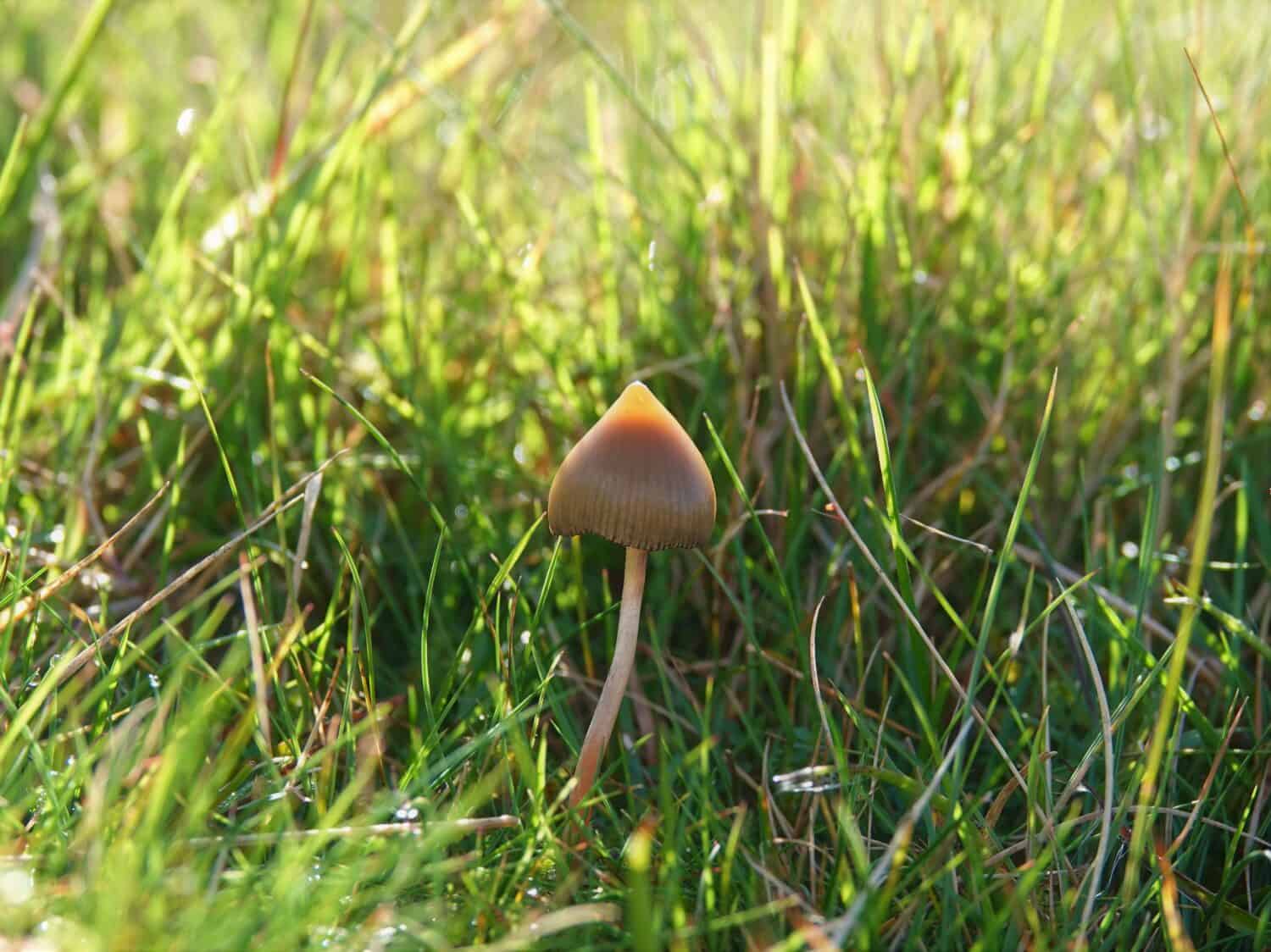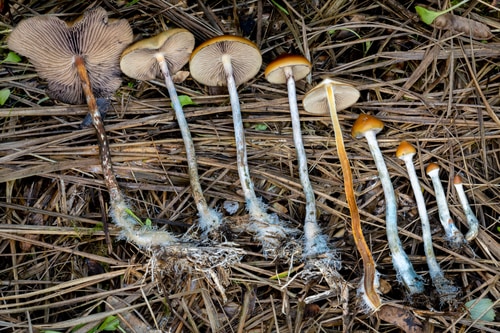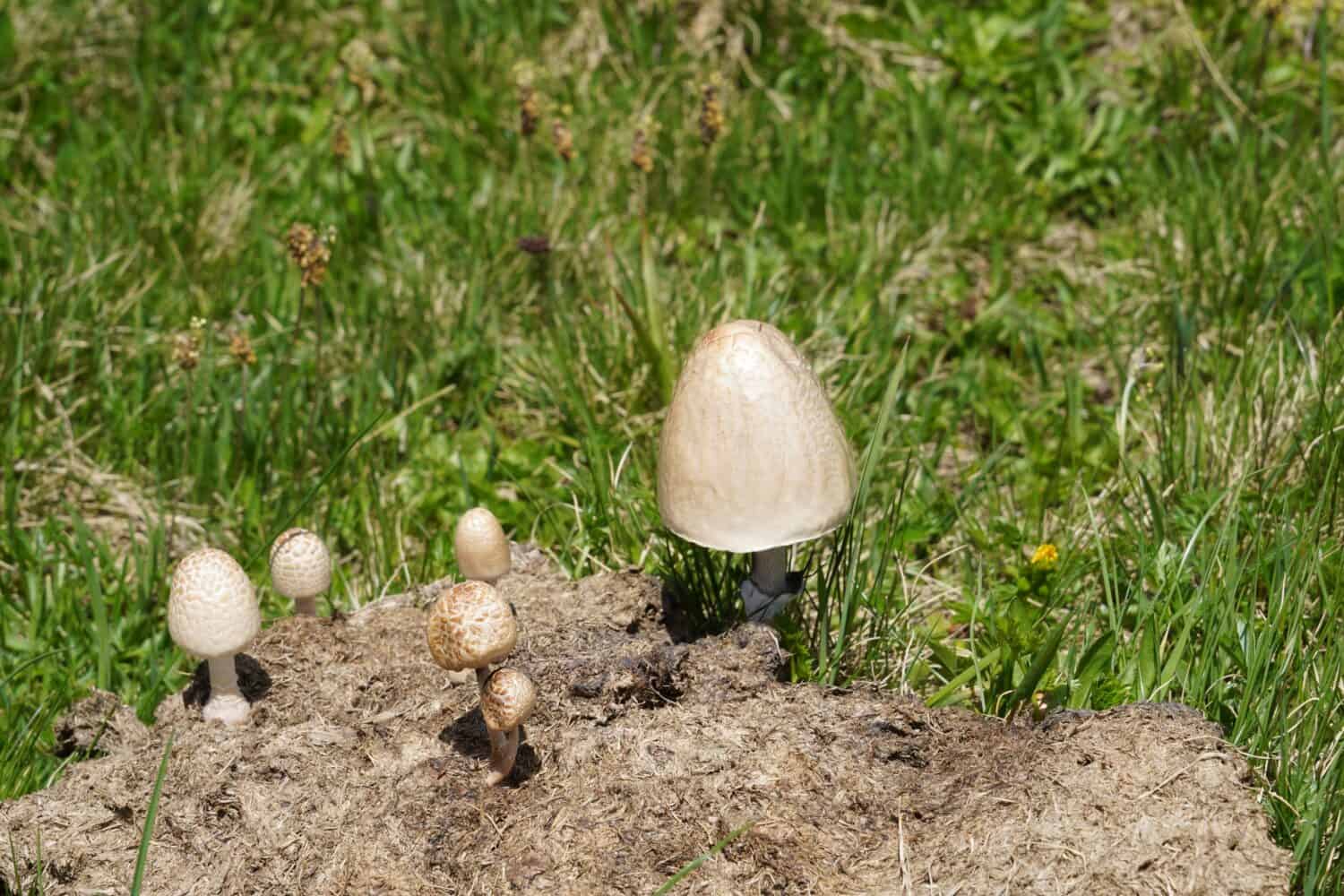If you’re interested in magic mushrooms, you may be familiar with liberty caps. These mushrooms contain psilocybin, the potent tryptamine gaining much attention in recent years as a possible treatment for addiction, depression, and PTSD. In this guide, we’ll discuss the fungal classification of liberty caps, where they commonly grow, and two mushrooms that look like liberty caps and grow in similar habitats with overlapping fruiting times.
Read on to learn more.
Liberty Caps: Fungal Classification, Distribution, and Ecology
Liberty caps (Psilocybe semilanceata) belong to the famed Psilocybe genus of gilled, hallucinogenic mushrooms in the Hymenogastraceae family. Psilocybe cubensis is a particularly well-known relative. Mycologists have formally identified at least 115 species in this genus. Currently, researchers estimate that over 300 species occur in the Psilocybe genus worldwide.
Nearly all of these mushrooms contain the psychoactive alkaloids, psilocin and psilocybin. The majority of species in Psilocybe are found in subtropical, humid forests. Some, however, are found in temperate climates of the Northern Hemisphere, including Psilocybe semilanceata.
Distribution
Liberty caps most frequently grow in temperate meadows, pastures, and lawns. They prefer rich and acidic soil, often growing in areas fertilized with sheep or cow manure. Unlike Psilocybe cubensis, however, Psilocybe semilanceata does not typically grow directly on manure.
Mycologists tend to agree that P. semilanceata is native to Europe and may have become naturalized in temperate regions of North America. This species is one of the most widespread and potent of psilocybin-producing mushrooms. It predominantly occurs in Europe and has been reported in 18 European countries. In the U.S., liberty caps occur on the West Coast from northern California into Washington state, west of the Cascades. Some specimens have even been reported in Alaska. In Canada, many specimens have been collected from provinces on the West Coast. There is some debate however if this species grows naturally on the East Coast.
Ecology
Liberty caps, like other species in the Psilocybe genus, are saprobic. This means they derive their nutrients from breaking down dead organic matter. In the case of P. semilanceata, it prefers to grow from late-stage decaying humus in fertile soils. They can grow solitarily or in groups. They fruit most abundantly in fall and early winter.
Mycologists are still studying the specific ecological roles that psilocybin-producing mushrooms might fill and how these psychoactive alkaloids benefit the fungi that produce them. One theory explains the production of psiloids as a deterrent from predation by fungivores. P. semilanceata, like others in its genus, tend to grow in nitrogen-poor environments and are scavengers of nitrogen. Their production of psilocybin may help defend against herbivores that seek to eat nitrogen-rich mushrooms in an otherwise nitrogen-poor environment. Another theory, currently less supported, suggests that the mushrooms may produce these psychoactive chemicals to influence the behavior of animals that spread their spores.
Morphology of Liberty Caps
Before we jump into discussing liberty cap lookalikes, we’ll discuss the physical characteristics (morphology) of Psilocybe semilanceata.
Cap
This mushroom has a conical to bell-shaped cap that can measure up to 1 inch in diameter. The top, centermost part of the cap features a small domed protrusion (umbo). The color of the cap is cream to golden brown. When moist, you can see fine, distinct dark brown, radial grooves that rise vertically along the cap. The flesh is delicate and membranous. The light-colored flesh quickly bruises blue-black upon damage.
Stipe
The stipe (like a plant’s stem) is slender, long, and typically cream to golden in color. It measures 1.5-6 inches long, often grows in a serpentine fashion, and tends to be slightly thicker towards the base. Sometimes, the base of the stipe is bluish.
Gills
On young specimens, the gills are grey-colored and narrowly attached to the stipe (adnex). As the mushroom matures, the gills turn a purple-black color, matching the color of the mature spores. Immature liberty caps have a thin cobweb-like partial veil that covers the gills. As the caps grow and expand, this veil breaks. Most mature specimens don’t have a veil remnant ring around the stipe.

This rather distinct looking mushroom is highly sought after by some people.
©Dewi Bwain/Shutterstock.com
Mushrooms That Look Like Liberty Caps
Below, we’ll cover two species of mushrooms that look like liberty caps. These mushrooms also grow in overlapping regions with P. semilanceata and fruit during the same periods.
Flying Saucer Mushroom (Psilocybe azurescens)
The flyer saucer mushroom (Psilocybe azurescens) is a psychoactive, psilocybin and psilocin-producing mushroom in the Psilocybe genus. Like liberty caps, it is particularly potent in its hallucinogenic properties.
Found in grassy, coastal, and humus-rich regions of the Pacific Northwest, and fruiting in fall and early winter, you could, at first glance, mistake Psilocybe azurescens for liberty caps. However, a closer inspection reveals a few distinguishing morphological characteristics.
Cap
The cap of P. azurescens can measure up to 4 inches across. As it matures, it expands from conical to convex-shaped to broadly convex to flattened with age. Like liberty caps, the cap of the flying saucer mushroom contains an umbo. However, the umbo on the cap of P. azurescens is larger and more pronounced. The color of the cap is usually light chestnut to caramel coloration. When mature, the margin is wavy and fully expanded outward. Cream-colored radial grooves run vertically and can reach about halfway up the cap under some environmental conditions. The flesh bruises blue when damaged.
Gills
While the gills of liberty caps are cream-colored when young, the gills of the flying saucer mushroom are light brown when young and stain purple-brown to purple-black upon maturity. These gills are less closely attached to the stipe than P. semilanceata. The spore print is purple-black.
Stipe
The stipe of P. azurescens can measure up to 8 inches tall. The color of the stipe changes as the mushroom matures from a creamy white to a mottled olive-grey to olive-brown with bluish hues. The base of the stipe often becomes increasingly covered in coarse white tufts of mycelium.

The base of the stipe of
Psilocybe azurescensoften becomes increasingly covered in coarse white tufts of mycelium.
©Alan Rockefeller / CC BY 4.0 / https://www.inaturalist.org/observations/84401768 – Original / License
Mushrooms That Look Like Liberty Caps: Shiny Mottlegill (Panaeolus semiovatus)
The shiny mottlegill (Panaeolus semiovatus) also amusingly called the egghead mottlegill, is widespread across temperate regions of Europe and North America. Some report this mushroom to be psychoactive, and indeed some species in Panaeolus contain psilocybin. However, researchers have yet to confirm the possible psychoactive properties of the shiny mottlegill.
A dung-loving species, Panaeolus semiovatus grows on the weathered manure of herbivores, most commonly horses and cows. While Psilocybe semilanceata does not grow directly on manure, you may still mistake these two mushrooms based on growing habitat. This is because the shiny mottlegill can grow on such weathered manure as to appear to be growing from the soil. This species fruits from late spring through early winter.
Cap
The cap of the shiny mottlegill can reach up to 3 inches across and features an off-white to tan coloration. Like liberty caps, the shiny mottlegill has a conical to bell-shaped cap. However, it lacks an umbo or radial grooves.
When wet, as the common name suggests, the cap is distinctly shiny. The margins may appear black or dark brown stained. When dry, the cap often becomes slightly wrinkled. The flesh is white or straw-colored and does not bruise blue when damaged. Infrequently, partial veil fragments may hang off the margin.
Gills
Like Psilocybe semilanceata, Panaeolus semiovatus contains a web-like partial veil that covers the gills when immature. The gills are light gray to light brown when young. As it matures, the gills develop black mottling. Eventually, the gills turn entirely black as the spores reach maturity. The spore print is black to gray-black.
Stipe
The stipe is thin and slightly broadens toward the base. It can measure up to 6 inches tall. The color is off-white to light tan. More commonly than liberty caps, the stipe of the shiny mottlegill contains a partial veil ring. This ring often stains black. The uppermost portion of the stipe also often becomes mottled with black speckles as the spores mature.

is a dung loving mushroom that is sometimes confused for Psilocybe.
©Luciavonu/Shutterstock.com
The photo featured at the top of this post is © Marek Prokes/Shutterstock.com
The information presented on or through the Website is made available solely for general informational purposes. We do not warrant the accuracy, completeness, or usefulness of this information. Any reliance you place on such information is strictly at your own risk. We disclaim all liability and responsibility arising from any reliance placed on such materials by you or any other visitor to the Website, or by anyone who may be informed of any of its contents. None of the statements or claims on the Website should be taken as medical advice, health advice, or as confirmation that a plant, fungus, or other item is safe for consumption or will provide any health benefits. Anyone considering the health benefits of particular plant, fungus, or other item should first consult with a doctor or other medical professional. The statements made within this Website have not been evaluated by the Food and Drug Administration. These statements are not intended to diagnose, treat, cure or prevent any disease.
Thank you for reading! Have some feedback for us? Contact the AZ Animals editorial team.







